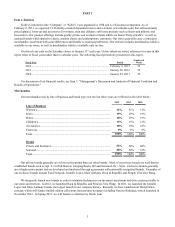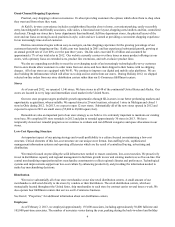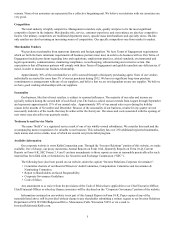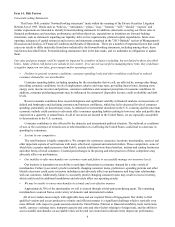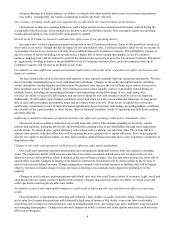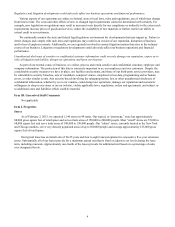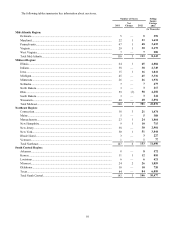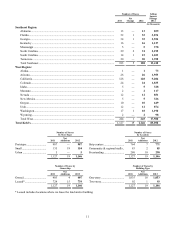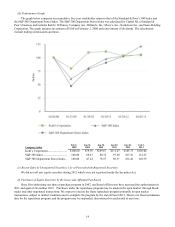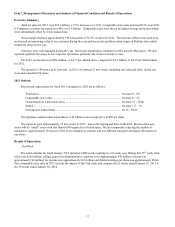Kohl's 2012 Annual Report Download - page 7
Download and view the complete annual report
Please find page 7 of the 2012 Kohl's annual report below. You can navigate through the pages in the report by either clicking on the pages listed below, or by using the keyword search tool below to find specific information within the annual report.7
If any of our significant vendors were to become subject to bankruptcy, receivership or similar proceedings, we may
be unable to arrange for alternate or replacement contracts, transactions or business relationships on terms as favorable as
current terms, which could adversely affect our sales and operating results.
• Increases in the price of merchandise, raw materials, fuel and labor or their reduced availability could increase our
cost of goods.
We could again experience inflation in our merchandise, raw materials, fuel and labor costs as we did during 2011.
The cost of cotton, which is a key raw material in many of our products, had the most dramatic increase in 2011. The price
and availability of cotton may fluctuate substantially, depending on a variety of factors, including demand, acreage devoted
to cotton crops and crop yields, weather, supply conditions, transportation costs, energy prices, work stoppages,
government regulation and government policy, economic climates, market speculation and other unpredictable factors.
Fluctuations in the price and availability of fuel, labor and raw materials, such as cotton, could again affect our cost of
goods and an inability to mitigate these cost increases, unless sufficiently offset with our pricing actions, might cause a
decrease in our profitability; while any related pricing actions might cause a decline in our sales volume. Additionally, any
decrease in the availability of raw materials could impair our ability to meet our production or purchasing requirements in
a timely manner. Both the increased cost and lower availability of merchandise, raw materials, fuel and labor may also
have an adverse impact on our cash and working capital needs as well as those of our suppliers.
• Ineffective marketing.
We believe that differentiating Kohl's in the marketplace is critical to our success. We design our marketing programs
to increase awareness of our brands, which we expect will create and maintain customer loyalty, increase the number of
customers that shop our stores and website and increase our sales. If our marketing programs are not successful, our sales
and profitability could be adversely affected.
• Damage to the reputation of the Kohl's brand or our private and exclusive brands.
We believe the Kohl's brand name and many of our private and exclusive brand names are powerful sales and
marketing tools and we devote significant resources to promoting and protecting them. We develop and promote private
and exclusive brands that have generated national recognition. In some cases, the brands or the marketing of such brands
are tied to or affiliated with well-known individuals. Damage to the reputations (whether or not justified) of our brand
names or any affiliated individuals, could arise from product failures, litigation or various forms of adverse publicity,
especially in social media outlets, and may generate negative customer sentiment, potentially resulting in a reduction in
sales, earnings, and shareholder value.
• Product safety concerns.
If our merchandise offerings do not meet applicable safety standards or our customers' expectations regarding safety,
we could experience lost sales, experience increased costs and/or be exposed to legal and reputational risk. Events that give
rise to actual, potential or perceived product safety concerns could expose us to government enforcement action and/or
private litigation. Reputational damage caused by real or perceived product safety concerns, could have a negative impact
on our sales.
• Disruptions in our information systems.
The efficient operation of our business is dependent on our information systems. In particular, we rely on our
information systems to effectively manage sales, distribution, merchandise planning and allocation functions. We also
generate sales though the operations of our Kohls.com website. The failure of our information systems to perform as
designed could disrupt our business and harm sales and profitability.
• Weather conditions could adversely affect consumer shopping patterns.
Because a significant portion of our business is apparel and subject to weather conditions in our markets, our operating
results may be adversely affected by severe or unexpected weather conditions. Frequent or unusually heavy snow, ice or
rain storms; natural disasters such as earthquakes, tornadoes, floods and hurricanes; or extended periods of unseasonable
temperatures in our markets could adversely affect our performance by affecting consumer shopping patterns, diminishing
demand for seasonal merchandise and/or causing physical damage to our properties.
• Inability to successfully develop and maintain a relevant omni-channel experience for our customers.
Omni-channel retailing is rapidly evolving as our customers become increasingly technologically savvy. Computers,
mobile phones, tablets and other similar devices are progressively becoming a more important aspect of the shopping
experience. Additionally, the internet and other new technologies facilitate competitive entry and comparison shopping.
We strive to offer an omni-channel shopping experience for our customers and use social media as a way to interact with
our customers and enhance their shopping experiences. If we are unable to make, improve, or develop relevant customer-



